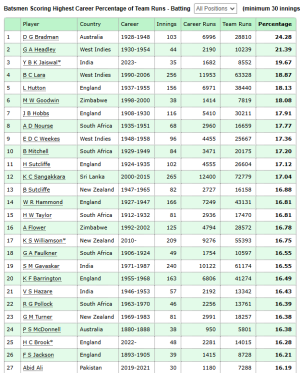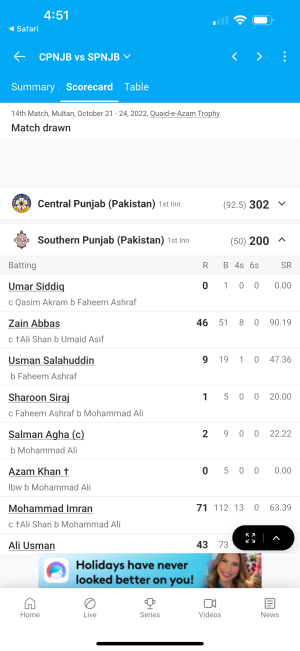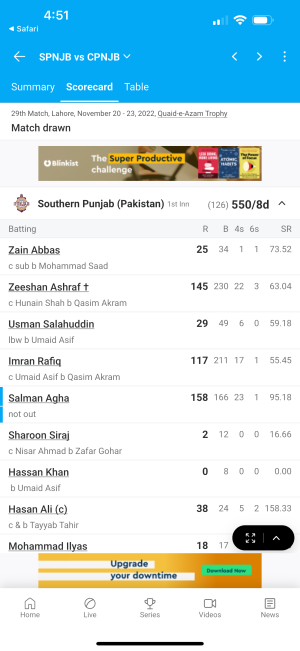- Joined
- Aug 1, 2023
- Runs
- 5,062
Percentage of Team Runs Scored in Test cricket
When analyzing player contributions in Test cricket, averages can sometimes be misleading because they don't always reflect the player's relative impact on the team. A fascinating metric I saw on HowStat is the "Percentage of Team Runs Scored in Test cricket". This stat highlights a player's contribution relative to their teammates, offering a better sense of who is genuinely carrying the batting load.
Here’s how the current crop of Pakistan Test batters rank based on this metric, sorted from highest to lowest contribution:
Saud Shakeel: 16.04% (Test average 53.79)
Babar Azam: 13.95% (Test average 43.66)
Abdullah Shafique: 12.26% Test average 38.56)
Imam ul Haq: 12.27% (Test Average 37.33)
Mohammad Rizwan: 11.18% (Test Average 41.55)
Shan Masood: 10.61% (Test Average 29.49)
Saim Ayub: 10.37% (Test Average 26.00)
Sarfaraz Ahmed: 10.19% (Test Average 37.42)
Salman Agha: 10.06% (Test Average 40.94)
Saud is head and shoulders, the head of the pack. Funnily enough, a player like Salman, who has a fairly high average, is only at 10%, which suggests that his runs are not as valuable compared to someone like Shan Masood, who has a significantly worse average.
And for reference sake, below is a list of the highest contributors to their team.
Abid Ali, funnily enough, is the highest of Pakistan (min 30 innings) at 16.19%, just above Saud.
The highest for India is Jaiswal at almost 20% which is ridiculous. Funnily enough, Sachin is at 14.82%, I thought it would be higher.
How about other Pak legends:
- Javed Miandad: 15.71%
- Younis Khan: 15.64%
- MoYo: 15.42%
- Saeed Anwar: 15.10%
- Inzi: 14.29%
- Imran Khan: 9.10%

When analyzing player contributions in Test cricket, averages can sometimes be misleading because they don't always reflect the player's relative impact on the team. A fascinating metric I saw on HowStat is the "Percentage of Team Runs Scored in Test cricket". This stat highlights a player's contribution relative to their teammates, offering a better sense of who is genuinely carrying the batting load.
Here’s how the current crop of Pakistan Test batters rank based on this metric, sorted from highest to lowest contribution:
Saud Shakeel: 16.04% (Test average 53.79)
Babar Azam: 13.95% (Test average 43.66)
Abdullah Shafique: 12.26% Test average 38.56)
Imam ul Haq: 12.27% (Test Average 37.33)
Mohammad Rizwan: 11.18% (Test Average 41.55)
Shan Masood: 10.61% (Test Average 29.49)
Saim Ayub: 10.37% (Test Average 26.00)
Sarfaraz Ahmed: 10.19% (Test Average 37.42)
Salman Agha: 10.06% (Test Average 40.94)
Saud is head and shoulders, the head of the pack. Funnily enough, a player like Salman, who has a fairly high average, is only at 10%, which suggests that his runs are not as valuable compared to someone like Shan Masood, who has a significantly worse average.
And for reference sake, below is a list of the highest contributors to their team.
Abid Ali, funnily enough, is the highest of Pakistan (min 30 innings) at 16.19%, just above Saud.
The highest for India is Jaiswal at almost 20% which is ridiculous. Funnily enough, Sachin is at 14.82%, I thought it would be higher.
How about other Pak legends:
- Javed Miandad: 15.71%
- Younis Khan: 15.64%
- MoYo: 15.42%
- Saeed Anwar: 15.10%
- Inzi: 14.29%
- Imran Khan: 9.10%










